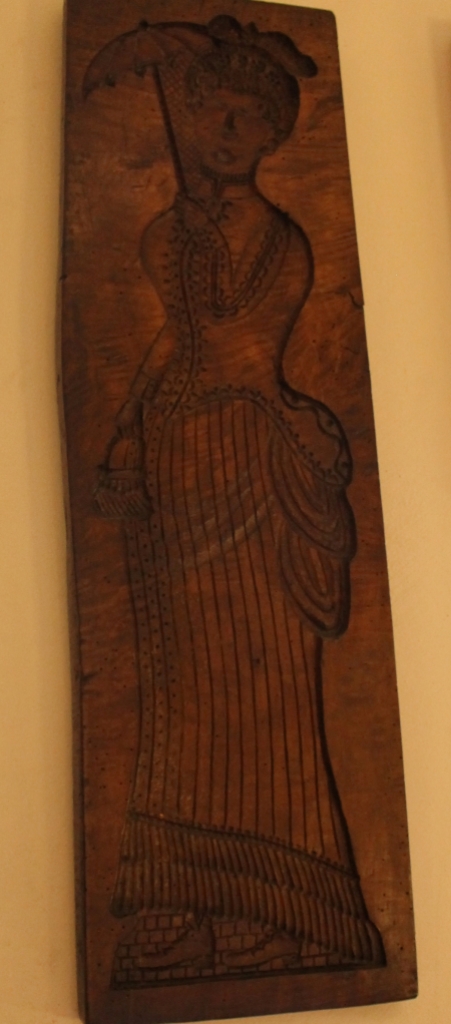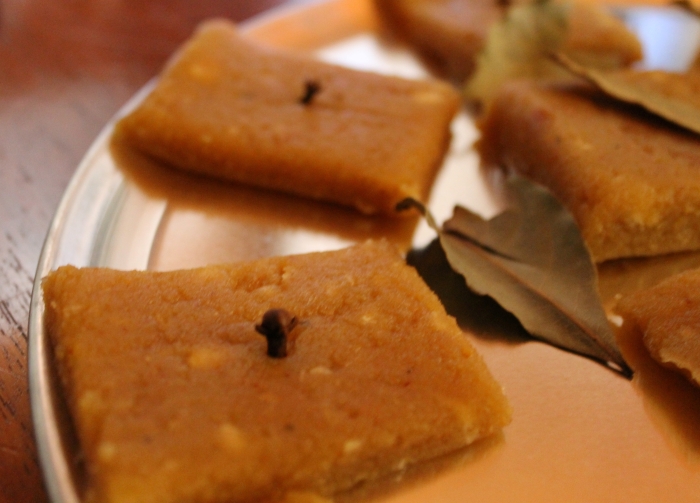The Historical Food Fortnightly Challenge for this fortnight was to make a dish that still exists, even if it is in a very different form. For me this was a great opportunity to try out a recipe which has intrigued me for a while now, gingerbread! But before you think “Oh but I make gingerbread all the time”, let me assure you, you’ve never had gingerbread quite like 15th century gingerbread.
The history of gingerbread is extremely complicated and as far as I can tell there is no clear evolution. It probably developed from Roman honeycakes, but in different ways in different regions of Europe. In France gingerbread is called pain d’epices, literally spice bread, but it is really a spiced cake like parkin from Northern England. In Scandinavia there are pepper cookies, and in Switzerland biber are filled with marzipan. Perhaps the most familiar are the spiced biscuits which are still made in Germany and Poland. Called lebkuchen and pierniki (you can see Sabrina Welserin’s lebkuchen recipes from 1553 here) these biscuits were produced by official guilds from about the 13th century.

The biscuit type of gingerbread is often shaped using detailed moulds, such as this 20th century mould which I saw Volkskunde (Folklore) Museum in Bruges, Belgium. This mould is unusual however because of its scale, it is at least a metre tall! To see more gingerbread moulds, check out my Pinterest board.
In England you can now find both types of gingerbread, but the earliest recipes are for a kind of candy made with honey, breadcrumbs and spices. One of the most popular recipes among re-enactors is the recipe from a manuscript written around 1430[1]. It is made from warmed honey and fresh breadcrumbs, and flavoured with spices but no ginger! It’s hotly debated whether leaving out ginger was deliberate or a mistake by the scribe.
A similar 14th century recipe calls for ginger, long pepper, sanders and cloves[2] while later recipes, such as ‘To Make Culler’d Ginger Bread’ from Martha Washington’s cookbook (which probably dates to 1650 or even earlier), use even more spices: cinnamon, ginger, cloves, mace, nutmeg, liquorice, sanders and aniseed[3]. These heavily spiced confections hark back to a medieval understanding of digestion. Based on Classical sources, doctors explained that cooking was the first step in digestion, and that the cooking process continued in the stomach. In order to discourage overcooking in the stomach it was important to eat things in the correct order, ideally following a series of steps:
- An aperitif to open the stomach and kick-start your digestion e.g. wine, fruit, nuts or spices candied in sugar or honey, fresh fruit and salad.
- Moderately warm and moist foods (according to the humours) which are easy to digest e.g. boiled and stewed foods, cereals, chicken and kid
- Foods that are difficult to digest e.g. cheese and other dairy products, venison, beef and pork.
- A digestif to close the stomach e.g. wine, nuts and candied spices (extra points if you can combine these in one recipe like hypocras, a spiced red wine)[4]
In this sense, serving gingerbread at the end of a meal showed your understanding of the latest medical advice, and that you were concerned for your guests’ welfare.
![George Flegel, Still Life with Bread and Confectionary, 17th century, [Public Domain] via Wikimedia Commons. Here you can see comifts, spices which have been covered in layer after layer of sugar, wine and a moulded biscuit, perfect for rounding off the meal.](https://turnspitandtable.files.wordpress.com/2014/11/george_flegel_still-life_with_bread_and_confectionary.jpg?resize=700%2C892)
George Flegel, Still Life with Bread and Confectionary, 17th century, [Public Domain] via Wikimedia Commons.
Here you can see comifts, spices which have been covered in layer after layer of sugar, wine and a moulded biscuit, perfect for rounding off the meal.
It wasn’t until much later that baked gingerbreads came to England, maybe as late as the mid 1600s, but they quickly acquired magical connotations. Miriam Hospodar claims that gingerbread figures were “originally prepared by crones for lovesick women”[5], explaining that women infused the biscuits with ginger because it was believed to be an aphrodisiac and then gave the man-shaped biscuits to the lucky (or unlucky) lover, thereby enslaving his heart forever. Helen Ostovich has also studied the symbolism of gingerbread and witchcraft in Early Modern theatre. Gingerbread in human shapes had especially strong magical associations and Puritans in particular feared their potential for enchantments and their similarity to idols. It’s not a huge leap from the contemporary trials of witches accused of crumbling clay figures of their victims to worrying about similar magic being performed with gingerbread, a substance that was already dangerously tempting and seductive[6].
The Recipe
Gyngerbrede. – Take a quart of hony, & sethe it, and skeme it clene; take Safroun, pouder Pepir, & throw there-on; take gratyd Brede, & straw there-on y-now; then make it square, lyke as thou wolt leche yt; take when thou lechyst hyt, an caste Box leves a-bouyn, y-styked ther-on, on clowys. And if thou woult haue it Red, coloure it with Saunderys y-now.[7]
The recipe is surprisingly straight forward, considering its age. It of course doesn’t give many quantities, but you can essentially spice it to taste. As to whether you should include ginger or not, I think that it’s a matter of personal preference, or you can do as I did and add ginger to half the recipe. I haven’t tried using sanders to colour the paste but it seems to be available online, or you can substitute it with a little food colouring.
I didn’t boil the honey very much at all, I think that the boiling and skimming was probably in order to get rid of any impurities and if you are working with honey that has already been processed then you don’t need to worry about it. Just bring the honey up to simmering point so that it’s nice and liquid in order to absorb the breadcrumbs.
The Redaction
Gingerbread
1 cup of honey
A pinch of saffron
1/2 tsp pepper, finely ground
Approx. 270g of fresh breadcrumbs (remove the crusts slices of slightly stale bread and whizz the bread in a food processor for a couple of seconds at a time until you reach an even consistency, or rub pieces of bread between your fingertips to do it the old-fashioned way)
1 tsp cinnamon, finely ground
1/2 tsp ginger, finely ground
Cloves and bay leaves to decorate*
- Heat the honey in a saucepan until it is just simmering. Dissolve the saffron in a little hot water then stir it into the honey with the pepper and cinnamon. Add the breadcrumbs and stir until the mixture has become a coherent mass. The honey should dissolve the breadcrumbs to form a mouldable paste, if it seems too wet add more breadcrumbs.
- Use wet hands to spread the paste into a baking tin lined with greaseproof paper or mould into small shapes. Leave in a cool place for several hours to harden up slightly.
- Turn the paste out onto a board and cut into squares or diamonds. You can decorate them with bay leaves and whole cloves. Make sure you remind people to remove the decoration before eating.
* The original recipe calls for box leaves but I used bay leaves instead as box leaves are poisonous.
The Recipe: Gyngerbrede from Harleian MS 279 in Two Fifteenth Century Cookbooks, edited by Thomas Austin (available here)
The Date: c. 1430
How did you make it? See above.
Time to complete?: 30 mins + cooling time.
How successful was it?: It was very different from modern gingerbread, more like a sweet than a baked good. It was very sweet so you can’t eat too much at a time, but it was pleasantly flavoured by the spices and quite chewy.
How accurate?: It’s hard to tell how much of each spice to put into the mixture, but I was quite happy with the amounts that I used. Next time I would like to experiment using sanders to colour the mixture, and it would be interesting to see how different types of bread change the texture.
[1] Thomas Austin, ed., Two Fifteenth-Century Cookery-Books: Harleian MS. 279 & Harl. MS 4016 with Extracts from Ashmole MS 1429, Laud MS. 553, & Douce MS. 55 (London: Printed for the Early English Text Society by N Trubner & Co., 1888), pg 35.
[2] Constance B. Hieatt and Sharon Butler, eds., “Goud Kokery,” in Cury on Inglysch, English Culinary Manuscripts of the Fourteenth Century (London, New York and Toronto: Published for the Early English Text Society by the Oxford University Press, 1985), No. 18, pg 154.
[3] Karen Hess, transcriber, Martha Washington’s Booke of Cookery and Booke of Sweetmeats (New York and Chichester, West Sussex: Columbia University Press, 1995), pg 345–346.
[4] Terence Scully, The Art of Cookery in the Middle Ages, 5th ed. (United Kingdom: The Boydell Press, 2005), pg 126–136.
[5] Miriam Hospodar, “Aphrodisiac Foods: Bringing Heaven to Earth,” Gastronomica: The Journal of Food and Culture 4, no. 4 (Fall 2004): 85.
[6] Helen Ostovich, “Gingerbread Progeny in Bartholomew,” in Magical Transformations on the Early Modern English Stage, ed. Lisa Hopkins and Helen Ostovich (England and USA: Ashgate Publishing, Ltd., 2014), pg 203–14.
[7] Austin, Two Fifteenth-Century Cookery-Books: Harleian MS. 279 & Harl. MS 4016 with Extracts from Ashmole MS 1429, Laud MS. 553, & Douce MS. 55, pg 35.
Austin, Thomas, ed. Two Fifteenth-Century Cookery-Books: Harleian MS. 279 & Harl. MS 4016 with Extracts from Ashmole MS 1429, Laud MS. 553, & Douce MS. 55. London: Printed for the Early English Text Society by N Trubner & Co., 1888.
Hess, Karen, ed. Martha Washington’s Booke of Cookery and Booke of Sweetmeats. New York and Chichester, West Sussex: Columbia University Press, 1995.
Hieatt, Constance B., and Sharon Butler, eds. “Goud Kokery.” In Cury on Inglysch, English Culinary Manuscripts of the Fourteenth Century, 147–56. London, New York and Toronto: Published for the Early English Text Society by the Oxford University Press, 1985.
Hospodar, Miriam. “Aphrodisiac Foods: Bringing Heaven to Earth.” Gastronomica: The Journal of Food and Culture 4, no. 4 (Fall 2004): 82–93.
Ostovich, Helen. “Gingerbread Progeny in Bartholomew.” In Magical Transformations on the Early Modern English Stage, edited by Lisa Hopkins and Helen Ostovich, 203–14. England and USA: Ashgate Publishing, Ltd., 2014.
Scully, Terence. The Art of Cookery in the Middle Ages. 5th ed. United Kingdom: The Boydell Press, 2005.



1 Pingback